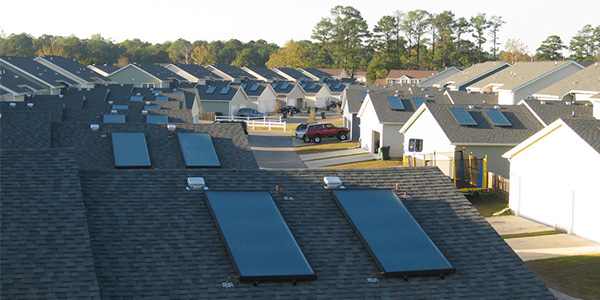By Holden Mann
Distributed energy resources such as rooftop solar panels and batteries may pose a higher risk for electric grid stability than previously thought, the chief engineer for San Diego Gas & Electric warned this week.
Sharing his observations of the more than 179,000 rooftop solar projects in SDG&E’s service territory, Thomas Bialek told NERC’s System Planning Impacts from Distributed Energy Resources (SPIDER) Working Group that the behavior of residential users of PV systems is often quite different than what system planners expect. The biggest contrast: Rather than satisfying part or all of a customer’s existing demand and taking the corresponding load off the wider grid, the installation of solar panels seems to lead customers to use even more power than they normally would.
“Effectively they say, ‘I’ve put a PV system on my roof, or a battery — I’m now in charge, and I’m going to do whatever it is I want to do,’” Bialek said. “What we’ve seen is that the residential customers with solar have maximum 15-minute demands that are 40% higher than those without solar, and … [67%] of residential solar customers have increased their demand in the second year after solar adoption, by … about 60%.”
The gap between expectation and reality has significant implications, creating what Bialek dubbed “hidden loads” that can’t be accounted for in system planning. Thanks in part to the California state government’s efforts to encourage renewable energy production, rooftop solar panels are now the single largest generating resource in SDG&E’s service territory with more than 1,200 MW of peak capacity.
But because utilities are not allowed to monitor the power generated by customers’ DERs, they are unable to use the systems’ capabilities to the extent they would like. For an operator like SDG&E, this means it cannot tune the output of DERs as effectively as it would like; more seriously, it can’t predict how users will behave in the event of widespread service disruptions or account for the possibility of large amounts of distributed generation going offline simultaneously.
Potential Cyber Threats
This scenario is particularly concerning in light of growing efforts by overseas hackers to target U.S. utilities. (See Report: Oil, Gas Hackers Expanding to Grid.) More than 58% of rooftop solar installations in SDG&E’s territory are provided by just two vendors, which poses a significant risk because hackers can often use the same attack vector against multiple types of systems from a single manufacturer.
“We bring that up because this is all behind-the-meter installations. We have our cybersecurity and our firewalls over our interfaces … but we don’t do that for any of the rooftop PV installations that are now using home Wi-Fi,” Bialek said. “To the extent that anyone can get to those particular systems, in our case you’d now be putting out about 600 MW AC [that are] potentially under the control of some bad cyber actor.”
Even without external disruptions, the electronic control systems of DERs can create unexpected issues for both users and utilities because of the complex interactions between software, hardware and the underlying physics of the energy resources themselves. Systems produced by the same manufacturer and even in the same production run can approach the same goal in widely different ways.
Despite these issues, Bialek stressed that the decentralized generation and storage capabilities of DERs can bring significant benefits to the larger grid. However, utilities must remain conservative in their expectations while the regulatory and security environment catches up. “Contrary to what all the DER providers will tell you, not everywhere is an opportune time for a DER to provide a service,” he said.




